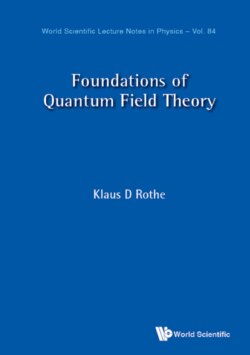Читать книгу Foundations of Quantum Field Theory - Klaus D Rothe - Страница 22
На сайте Литреса книга снята с продажи.
3.3The Klein–Gordon equation
ОглавлениеOne tentative way out to save Lorentz covariance in the presence of interaction would be to treat space and time from the outset on equal footing by working with a differential equation of second order in space as well as time. This equation should nevertheless contain the solution discussed previously. Noting that
one is thus led in the absence of interaction, to the Klein–Gordon equation
The general solution of this equation is now given by
where
The solution (3.9) thus represents in general two wave packets moving away from each other with time. If we choose the Fourier amplitudes a(+)(k) and a(−)(k) to be concentrated around , then these two wave packets will separate from each other with twice the group velocity
which could be interpreted as a two-particle state. Since
we may regard the solution ϕ(−) as solutions of the Schrödinger equation for negative energy. These negative energy solutions do not fit into our probabilistic interpretation, since with the scalar product (3.6),
The negative energy solutions of the KG equation thus carry negative norm with respect to the scalar product (3.6). In the free case we may nevertheless ignore their existence, since they satisfy the orthogonality property
and as a result we have no mixing of positive and negative energy solutions:
Thus we may restrict ourselves to the positive energy sector of the theory. This will, however, no longer be true if we allow for interactions with an external potential, which will induce transitions between positive and negative energy states.
